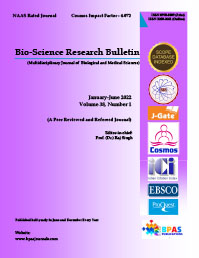Chemical Signals in Immunology
DOI:
https://doi.org/10.48165/Keywords:
Cytokines, Oxygen Radicals, Bax-Bcl Ratio, Null Mutation, Cellular Response, Ca2+/calmodulin, thrombus, Injury, Caspase-3Abstract
Kianic acid, glutamate, radiation and plant extracts are substances that produce a chemical signal in cell systems. These substances have the ability to upregulate caspase-3 expression, as well as a result in the migration of cellular components, viz. mast cells and macrophases, at the site of inflammation. This communication discusses chemical signal in immunology and their importance in regulating cellular responses.
References
Cohen, O; Feinstein, E; Kimchi, A. (1997). DAP-kinase is a Ca2+ dependent, cytoskeletal associated protein kinase, with cell death-inducing functions that depend on its catalytic activity. EMBO Journal, 16, 998 – 1008.
Crumrine, R.C., Thomas, A.L., Morgan, P.F. (1994). Attenuation of p53 expression protects against focal ischemic damage in transgenic mice. Journal of Cerebellar Blood Flow and Metabolism, 14, 887 – 891.
General Principles of Cellular Communication, Open University, Open Learning, 2020. 4. Hengartner, M.O. (2000). The biochemistry of apoptosis. Nature, 407, 770 – 776. 5. Jia, Y-Ji; Li, I; Quin, Z.H. and Liang, Q.Z. (2009). Autophagic and apoptotic mechanisms of
curcumin-induced death in K562 cells. Journal of Asian Natural Products Research, 11, 918 – 928. 6. Mallat, Z. and Tedgui, A. (2000). Apoptosis in the vasculature: mechanisms and functional importance. British Journal of Pharmacology, 130, 947 – 962.
Mallat, Z. and Tedgui, A. (2001). Current perspectives on the role of apoptosis in antherosclerotic disease. Circulatory Research, 88, 998 – 1003.
Martinet, W., Schrijvers, D.M., De Meyer, G.R.Y., Thielemans, J., Knaapen, M.W.M., Herman, A.G. and Kockx, M.M. (2002). Gene expression profiling of apoptosis-related genes in human antherosclerosis: upregulation of death-associated protein kinase. Antherosclerosis, Thrombosis and Vascular Biology, 22, 2023 – 2029.
Slacks, R.S., Bellivea, D.J., Rosenberg, M., Atwal, J., Lochmuller, H., Aloyz, R., Haghighi, A., Lach, B., Seth, P., Cooper, E. and Miller, F.D. (1996). Adenovirus-mediated gene transfer of the tumour suppressor, p53, induces apoptosis in postmitotic neurons. Journal of Cellular Biology, 135, 1085 – 1096.
Singh, R. and Reddy, L. (2012a). Molecular immunogenetics of apoptosis: Experimental dilemmas. International Journal of Biological and Pharmaceutical Research, 3 (4), 550 – 559. 11. Singh, R. and Reddy, L. (2012b). Apoptosis in the human laryngeal carcinoma (Hep-2) cell
line by Bulbine natalensis and B. frutescens fractions. International Journal of Biological and Pharmaceutical Research, 3 (7), 862 – 874.
Singh, R. (2020). pers.com, RSA.
